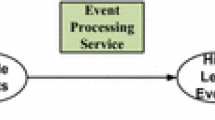Abstract
The fact-based approach (NIAM, ORM, FCO-IM, CogNIAM) provides modeling constructs for the data- and process-oriented perspectives for domain business rules for ERP requirements determination. The event perspective in business rule modeling has been given less emphasis in the fact-based research community. In this paper we will define a number of modeling constructs that allow us to model ‘event-perspective’ business rule semantics in a declarative way that builds on the existing fact-based modeling constructs for business rules in the data and process perspectives.
Access this chapter
Tax calculation will be finalised at checkout
Purchases are for personal use only
Similar content being viewed by others
Notes
- 1.
- 2.
It is sufficient to only denote the object type in the event argument. The accompanying naming convention for the object type is captured in the fact-based information diagram (see Fig. 2 for this example).
References
Herbst, H., Business rules in systems analysis: a meta-model and repository system. Inf. Syst. 21(2), 147–166 (1996)
Kardasis, P., Loucopoulos, P.: Expressing and organising business rules. Inf. Softw. Technol. 46, 701–718 (2004)
Rai, V.K., Anantaram, C.: Structuring business rules interactions. Electron. Commer. Res. Appl. 3, 54–73 (2004)
Halpin, T., Morgan, T..: Information Modeling and Relational Databases; from Conceptual Analysis to Logical Design, 2nd edn. Morgan-Kaufman, San-Francisco (2008)
Nijssen, M., Lemmens, I.: Verbalization for business rules and two flavors of verbalization for fact examples. In: OTM Workshops 2008. Springer, Monterrey (2008)
Bollen, P.: Enterprise resource planning requirements process: the need for semantic verification. Lect. Notes Inf. Syst. Organ. 4, 53–67 (2013)
Bollen, P.: Extending the ORM conceptual schema design procedure with the capturing of the domain ontology. In: EMMSAD ‘07.2007. Tapir, Trondheim, Norway
Halpin, T.: Information Modeling and Relational Databases; From Conceptual Analysis to Logical Design. Morgan Kaufmann, San Francisco (2001)
Rolland, C.: Database dynamics. Data base (spring): pp. 32–43 (1983)
Casati, F., Fugini, M., Mirbel, I.: An environment for designing exceptions in workflows. Inf. Syst. 24(3), 255–273 (1999)
Koschel, A., Lockemann, P.C: Distributed events in active database systems: Letting the genie out of the bottle. Data Knowl. Eng. 25, 11–28 (1998)
Bollen, P.: Conceptual process configurations in enterprise knowledge management systems. In: Applied Computing 2006. ACM, Dijon, France
Diaz, O., Piattini, M., Caleor, C.: Measuring triggering-interaction complexity on active databases. Inf. Syst. 26(1), 15–34 (2001)
Adaikkalavan, R., Chakravarthy, S.: SnoopIB: interval-based event specification and detection for active databases. Data Knowl. Eng. 59, 139–165 (2006)
Tan, C.W., Goh, A.: Implementing ECA rules in an active database. Knowl.-Based Syst. 12, 137–144 (1999)
Bollen, P.: On the applicability of requirements determination methods. In: Management and Organization. University of Groningen: Groningen. p. 219 (2004)
Dietrich, S.W., et al.: Component adaptation for event-based application integration using active rules. J. Syst. Softw. 79(12), 1725–1734 (2006)
Bassiliades, N., Vlahavas, I.: Processing production rules in DEVICE, an active knowledge base system. Data Knowl. Eng. 24, 117–155 (1997)
Pissinou, N., Makki, K., Krishnamurthy, R.: An ECA object service to support active distributed objects. Inf. Sci. 100, 63–104 (1997)
Paton, W., (ed.): Active rules in database systems. In: Gries, D. (ed.) Monographs in Computer Science. Springer, New York (1999)
Author information
Authors and Affiliations
Corresponding author
Editor information
Editors and Affiliations
Rights and permissions
Copyright information
© 2016 Springer International Publishing Switzerland
About this paper
Cite this paper
Bollen, P. (2016). Fact-Based Declarative Business Rule Modeling for the Static and Dynamic Perspectives in ERP Applications. In: Piazolo, F., Felderer, M. (eds) Multidimensional Views on Enterprise Information Systems. Lecture Notes in Information Systems and Organisation, vol 12. Springer, Cham. https://doi.org/10.1007/978-3-319-27043-2_10
Download citation
DOI: https://doi.org/10.1007/978-3-319-27043-2_10
Published:
Publisher Name: Springer, Cham
Print ISBN: 978-3-319-27041-8
Online ISBN: 978-3-319-27043-2
eBook Packages: Business and ManagementBusiness and Management (R0)




